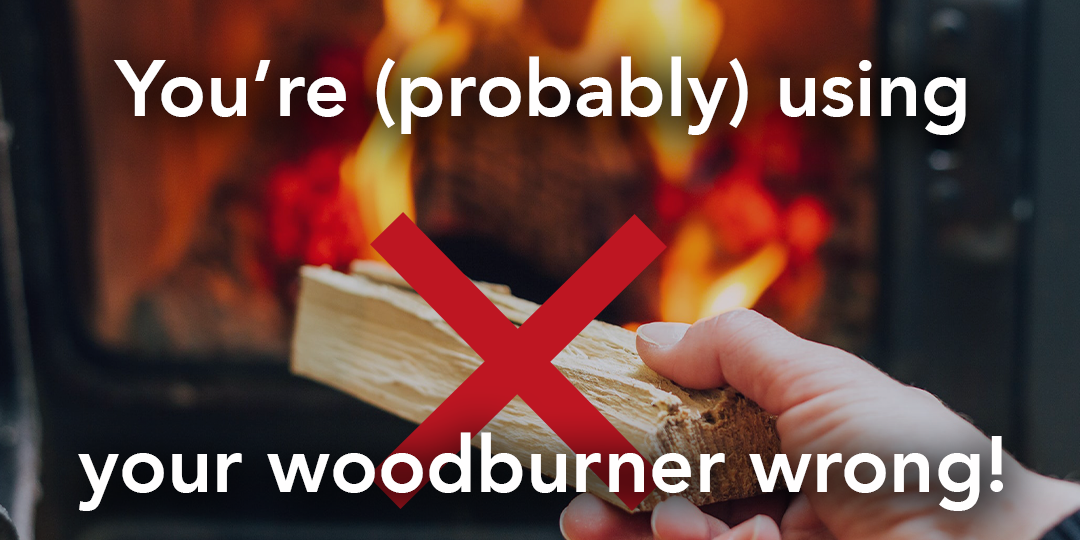Using a woodburner is quite straightforward in nature. You light the fire, get the stove up to running temperature and then moderate the wood and the air entering the stove to achieve the optimum burn. Straightforward, sure, but not so simple when you get down to what is actually happening when following these steps below.
Your woodburner works on negative pressure. This means that your stove ‘sucks’ in air thanks to the natural pull of the chimney and the gradient between the heat in your home and the cool air outside (that is to say, in the winter atleast). As the air entering the firebox mixes with the gases released from the fuel, combustion happens and voila, you have heat. As with any reaction, there are of course by-products which are given off. These by-products are then drawn up the chimney as the stove sucks in fresh air to continue the combustion process.
Now the air that the stove is sucking in comes from the immediate area that the stove is situated in. As the stove sucks in air from the room, a vaccum is created and new air is sucked into the room to replace the air the stove has just drawn in.
As we all know, Old French houses are drafty. This works great for your fire as it becomes super easy for the air, drawn by the stove to be replaced by pulling in fresh air from outside. This whole process works flawlessly up until the point where the reliably drafty old French house is modernised, say, with double glazed windows and all of a sudden, the air from outside can no longer get in.

Multiple times a year I receive phone calls of “My chimney is not lighting properly” or “My stove is behaving differently” and 9 times out of 10, the caller has just had lovely new double-glazed windows installed and their woodburner no longer has somewhere to draw air from. All of a sudden, the stove glass on the woodburner is turning black, the stove itself is stalling or worst of all, dangerous smoke may enter back into the room.
If you think you may be having a similar issue there is a test you can perform to see if you are having a ventilation issue with your fire. Simply try lighting your fire and running your stove with and without exterior windows and doors open. If there is a noticeable difference between the two conditions, and your fire is performing better with the window/door open you are likely having an issue with an insufficient supply of air into the room.
So, what is the answer to solving this problem? Two words: Air Vent. By regulation, any stove over 5kw should have an air vent installed in the room of the appliance, however with DIY installations being as common as they are in France, this small, yet incredibly important piece of the puzzle is far too often missed.
Suggesting an air vent is usually met with cries of “Oh, but it will make a draft in my house” or “won’t it let insects into my home?”. Placement is key when it comes to installing an air vent. The closer the vent is to the fire, the less chance you have of ever feeling a draft in your home but even with a further away placement of the vent, it is unlikely the stove will be drawing so aggressively that you will feel even the slightest breeze. As for the insects, most vents are equipped with an insect preventing mesh to stop critters getting anywhere near your living space – just make sure you install a mesh equipped vent and you’ll never have to worry about such an issue.

Nowadays, most double glazed doors and windows come equipped with a ‘trickle vent’ to improve the air quality in the room and to prevent condensation building up. Another advantage of these are of course that they allow the air required by the woodburner to be drawn into the room, preventing the aforementioned vacuum being built up and leading to complications with your appliance.
These same principals work exactly the same for an open fire, infact, your open fire will require more air than your woodburner to displace the by-products of combustion in your much larger brick chimney.
Modernising and draft proofing your home is a brilliant thing to do. Trapping the heat in and stopping excessive, unregulated, cool air entering your home is one of the most efficient and cost effective ways of reducing your energy bill and your carbon footprint. Just make sure if you enjoy the benefits of having a functioning fireplace in your house, you ensure you have sufficient air coming in to allow things to work properly.





